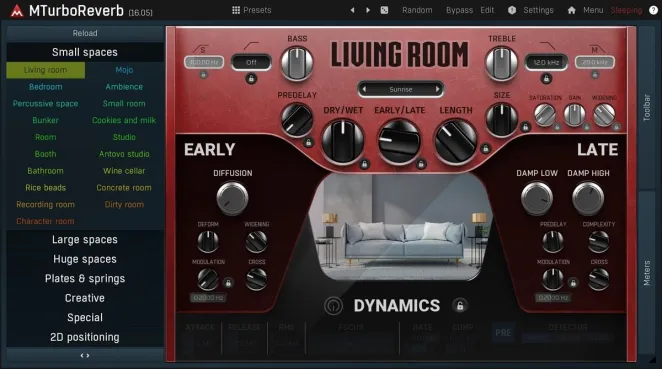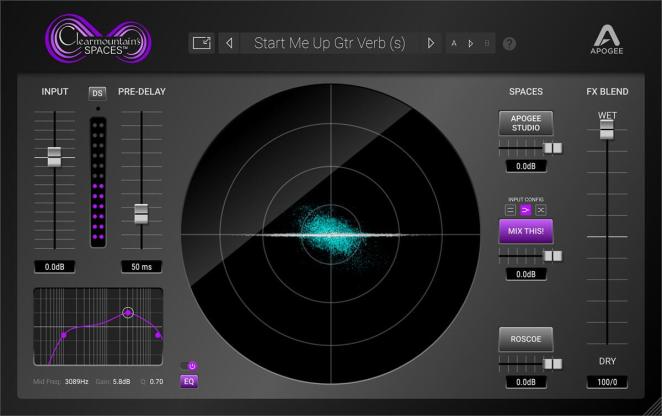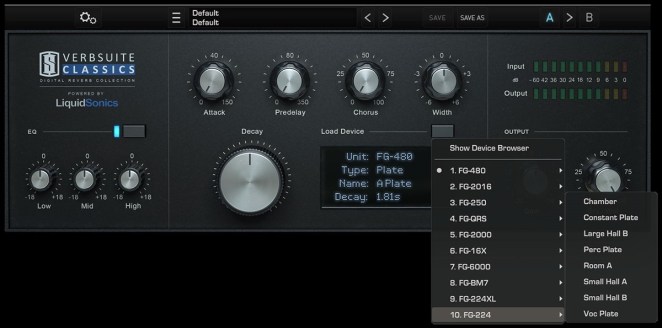When you buy through our links, we may earn an affiliate commission.
Would you like to find that perfect reverb sound that will finally allow you to bring your mixes together in a cohesive and pleasing way?
The best reverb plugins will give your projects that extra pro sound by bringing every track together into a harmonious space. A good reverb will not only improve your overall sound but also serve as a tool for creating lush and intimate atmospheres.
In this article, we have picked out the best reverb plugins on the market, no matter if you're an expert or a beginner producer. We also threw in a quick buyer's guide to help you find the perfect reverb plugin for you and your projects!
Our #1 pick is the MeldaProduction MTurboReverb, as it offers almost 100 different reverb styles without sacrificing the basic controls.
The best reverb plugins will elevate your mixes to a whole new level, and even act as a creative tool to catch every drop of inspiration.
Quick Summary of the Best Reverb Plugins
- MeldaProduction MTurboReverb (Best Overall)
- Apogee Clearmountain Spaces (Best for Those on a Budget)
- Zynaptiq Adaptiverb (Best Cutting-Edge Plugin)
- Sonible smart:reverb (Best for AI Reverb)
- Slate Digital VerbSuite Classics (Best for Convolution)
- Eventide ShimmerVerb (Best Shimmer Reverb)
- WaveArts MasterVerb (Best for Full Control)
- IK Multimedia T-RackS Sunset Sound Studios (Best for Studio Sounds)
- Baby Audio Crystalline (Best for Algorithmic Reverb)
- Kilohearts Convolver (Best for Experimental Convolution)
Best Reverb Plugins
Best Overall
SPECS
- Type of reverb: Acoustic, mechanical, and digital
- Number of presets: Almost 100
- Allows custom reverbs: Yes
Very few companies can even dream of creating products as innovative and proficient as Melda — and, of course, their reverb is no exception to this. The MeldaProduction MTurboReverb is an all-in-one solution to all your reverb needs!
Packing nearly 100 unique reverb tones and algorithms, the MTurboReverb can adapt to any project and idea. From deep spaces and galactic ambiances to realistic rooms and pitch-perfect mechanical emulations, this plugin has it all.
But if that weren't enough, the MeldaProduction MTurboReverb offers full control over its programmable engine, allowing you to create your own reverbs!
Best for Those on a Budget
SPECS
- Type of reverb: Acoustic
- Number of presets: 8
- Allows custom reverbs: No
The Apogee Clearmountain Spaces isn't bothered by gigantic reverb plugins that offer dozens of algorithms. Instead, it focuses on just three customized spaces and eight presets based on the preferences of legendary producer Bob Clearmountain.
The first reverb included in Clearmountain Spaces is the Apogee Studio — a short, warm reverb based on a top-notch recording studio. The second one, Mix This!, is a medium-length algorithm with a bright sound. And finally, the Roscoe reverb is an extra-long, extra-rich ambiance for the most dreamy music-makers!
Everything inside this plugin has been designed with the help of Bob Clearmountain himself, so rest assured you're getting the best of the best. And the best part? The affordable price tag makes it a fantastic choice even for the most amateur of producers.
Best Cutting-Edge Plugin
SPECS
- Type of reverb: Mostly digital
- Number of presets: 400+
- Allows custom reverbs: Yes
Zynaptiq Adaptiverb merges together many of the latest advancements in reverb technology. Unlike most reverb plugins, Adaptiverb isn't focused on creating the most realistic reflections, instead opting for creating cohesive spaces through cutting-edge technology.
Primarily, Zynaptiq Adaptiverb implements advancements such as ray tracing, source separation, and artificial intelligence to create lush and harmonic reverbs. All of this helps create cohesive spaces that adapt to any track, so you can forget about reverb tails muddening your mix!
Adaptiverb goes as far as allowing you to control which notes are included inside the reverb tails. We know that all of this can sound a bit hard to manage — luckily, the 400+ presets included will help you get your reverbs sounding right out of the gate.
Best for AI Reverb
SPECS
- Type of reverb: Acoustic, mechanical, and digital
- Number of presets: None
- Allows custom reverbs: Yes
Reverb is a complex effect that can absolutely make or break your mix. But what if you could have all the knowledge of a pro engineer with just a few clicks? Well, the Sonible smart:reverb offers just that, taking advantage of the latest advancements in artificial intelligence.
The process is as simple as it gets: launch the plugin, click learn, and feed it some audio. In a matter of seconds, smart:reverb will detect which ambiance will better suit your track thanks to a wide library of ready-to-go reverb profiles.
From there on, it's all up to you. Sonible smart:reverb will give you full control, complete with reverb time, wet/dry, pre-delay, and all the other classic parameters. Or you could opt to use the XY pad to swing between natural, artificial, rich, and intimate ambiances.
Best for Convolution
SPECS
- Type of reverb: Digital
- Number of presets: 8
- Allows custom reverbs: No
Slate Digital VerbSuite Classics is set on doing one job and one job only: giving you access to the most exclusive reverbs on the market. From German 80s ambiances to modern all-in-one solutions, the Digital VerbSuite offers eight digital reverbs that are sure to work in any context.
A big part of the Slate Digital VerbSuite Classics is, of course, convolution — which guarantees pitch-perfect emulations in each case. The detail inside the reflections of each model is simply breathtaking, capturing each and every tonal nuance imaginable.
Naturally, all of the classic controls are included: decay time, attack, pre delay, width, and dry/wet. If you want to tweak it even further, the 3-band EQ and adjustable chorus will help you get that final extra touch.
Best Shimmer Reverb
SPECS
- Type of reverb: Digital
- Number of presets: 20+
- Allows custom reverbs: No
There are few things as pleasing as a heavenly lush shimmer reverb hovering over a few tracks in your mix. The Eventide ShimmerVerb gives you the chance to bring all your shoegaze dreams to life, offering a classic yet unique take on shimmer reverbs.
If you're a guitarist, you may be used to shimmers with two or three knobs. Well, that's not the case with ShimmerVerb — this absolute powerhouse of a plugin wants to give you full control. You can tweak delay times, pitches, EQ, feedback, and even tempo.
Of course, shimmer reverb plugins aren't fit for every track. But when the time comes to create a lush, dreamy atmosphere, few algorithms beat the Eventide ShimmerVerb.
Best for Full Control
SPECS
- Type of reverb: Acoustic and mechanical
- Number of presets: 60+
- Allows custom reverbs: Yes
WaveArts MasterVerb's only goal is to give you full control over your reverb tails. And when we say full control, we really mean full control. Taking a quick look at the GUI should give you an idea of just how much of a beast this plugin is.
Like others on this list, the WaveArts MasterVerb opts to focus on just two reverbs: hall and plate. After choosing between them, you have total control over the algorithm —from early and late reflections to the overall envelope, everything can be adjusted.
And the best part? Everything is nicely plotted into 3D frequency and time response graphs. Forget about wild experimental plugins that are impossible to tame: the MasterVerb will gladly follow all your orders.
Best for Studio Sounds
SPECS
- Type of reverb: Acoustic and mechanical
- Number of presets: None
- Allows custom reverbs: No
Sometimes, you just don't want to deal with endless tweaking to get a good-sounding reverb. The IK Multimedia T-RackS Sunset Sound Studios is as simple as it looks. Just insert it into a track and enjoy the reverb of a legendary Hollywood recording studio right from your home.
The IK Multimedia T-RackS Sunset Sound Studios includes a live room, iso booth, three echo chambers, and three plate and spring reverbs. Each of these captures the spirit and nuances of the iconic Sunset Sound studios, where artists such as Led Zeppelin and Toto recorded legendary albums.
Of course, all of the classic reverb controls are included — but the spirit behind the plugin is, fundamentally, plug-and-play. Even if you're a beginner producer, the T-RackS Sunset Sound Studios will be the right pick for you.
Best for Algorithmic Rever
SPECS
- Type of reverb: Digital
- Number of presets: 300+
- Allows custom reverbs: Yes
Algorithmic reverb has been a thing for decades now, and the Baby Audio Crystalline is here to clash each and every advancement into a single plugin. The sheer amount of control this plugin offers is just breathtaking, with dozens of creative features and settings.
The Baby Audio Crystalline is divided into four sections: reflections, depth, clean-up, and shape. Each of these has three sub-sections, allowing you to tweak the algorithm to its fullest extent. From 80s-inspired gated reverbs to abysmal, spacey ambiances, everything is possible with this one.
And there's just no way to gloss over the beautiful interface at the forefront of the plugin. Sleek and clean, the Baby Audio Crystalline is sure to recover the joy of endlessly messing around with knobs, toggles, and faders!
Best for Experimental Conv
SPECS
- Type of reverb: Digital
- Number of IRs: 300+
- Allows custom reverbs: Yes
Convolution reverbs are commonplace in most modern studios. However, most of them offer just a few impulse responses, limiting the creativity of experimental sound designers. The Kilohearts Convolver is here to change that, focusing on experimental convolution reverb and sound design.
The Kilohearts Convolver packs a simple interface that's focused on the IRs themselves. With just three knobs, a delay control, and basic envelope tweaking, this plugin wants you to focus on the source material instead.
You can use the Kilohearts Convolver to emulate classic reverb sounds, but its true power relies elsewhere. What would happen if you were to fuse together a piano and a metal can? What about a voice and a guitar? Experimenting is the name of the game with this one!
Best Reverb Plugins Buyer's Guide
Navigating the world of reverb plugins can be quite the challenge — especially if you aren't a veteran producer. From algorithmic reverbs to impulse responses, there are thousands of options for each and every sound designer's needs.
But fret not! Whether you're looking for otherworldly soundscapes or natural room resonances, our reverb plugin buyer's guide will help you find the right pick for you. Here are the four most important aspects to keep in mind:
Types of Reverb
First of all, you should try to determine which type of reverb is best for you and your projects. Mainly, there are three types of reverb plugins: acoustic, mechanical, and digital.
Acoustic reverb plugins emulate real spaces, such as churches and concert halls. Famous acoustic reverbs include room, chamber, hall, and cathedral. These are ideal for emulating a realistic reverb that doesn't sound out of place in acoustic or live mixes.
Mechanical reverb plugins, on the other hand, are based on large hardware devices that create artificial spaces. The two most common mechanical reverbs are spring and plate, which are widely used by the music industry as a whole. While they may not sound as realistic as acoustic reverbs, mechanical ones give your sound that extra professional touch.
And last but not least, digital reverbs make up for the latest advancements in reverb plugins, offering effects such as convolution, reverse, non-linear, and shimmer. These are ideal for advanced sound designers who are looking to take their reverb to the next level, as they offer near-endless sonic possibilities.
Realistic vs Experimental
Defining whether you want realistic or experimental sound reflections is an essential part of picking your ideal reverb plugin. Realistic reverbs are a sure-proof way to make your tracks stand out in the mix and give your project that extra feel-good factor. However, experimental reverb plugins open up a whole new sonic playground that'll elevate pretty much any instrument.
Realistic reverbs include both acoustic and mechanical reverbs. Reverbs like spring and room are pretty much the golden standard in the music industry, but don't let that scare you away from experimental plugins!
Experimental reflections may be as simple as a shimmer — a type of digital reverb that was widely used during the 90s in the alternative rock scene. Other plugins, such as the Baby Audio Crystalline, take it to a whole new level by fusing non-linear reverbs with heavy modulation, filtering, and distortion to create surreal soundscapes.
Modulation
You may have noticed by now that most reverb plugins include a "modulation" or "depth" knob alongside the filter controls. Reverb itself isn't a modulation effect — so what's this all about?
Well, reverb designers realized that, sometimes, achieving natural-sounding reflections just doesn't cut it. As such, it became standard to add some sort of modulation effect to the wet signal to give the reverb a sort of breathing or morphing motion.
Each plugin will use different modulation effects, but vibrato and tremolo are two of the most common ones included. Phaser, chorus, and flanger may also be present in more experimental reverbs — although they may only be noticeable if you crank the modulation knob all the way up.
All in all, modulation is essential to give your reverbs that extra touch. Unless you're looking to only use the most natural-sounding reverb plugins, you should always check out the modulation capabilities of your desired plugin!
Basic Controls
This one may sound a bit obvious, but keeping an eye out for the basic controls is always a good idea when shopping for your new reverb plugin. Many modern amateur plugins sometimes skip these in favor of adding newer, more experimental features.
Decay time, reverb tail, early reflections, pre-delay, and dampening are some of the most basic knobs a reverb plugin should include without exceptions. Lacking one of these will come back to bite you down the road — even if you're an experienced sound designer.
Luckily, all of the plugins on this list include these controls so you don't have to worry about this for the moment!
It's also important to keep in mind that convolution reverbs or other experimental digital plugins may skip some of these. This is because non-traditional reverbs don't follow the same parameters, so these factors are controlled by other knobs that may be named differently.
Frequently Asked Questions (FAQs)
What is the most popular reverb of all time?
The answer to this question depends on how you look at reverbs. If you take into account live recordings, then acoustic reverbs such as room and hall reverbs are by far the most common, as they're used both in live and studio mixes.
However, if you're only considering studio recordings, then the answer is probably spring or plate reverb. These two were must-haves in any decent studio before the digital era, and many producers still use them for their realistic and highly adjustable responses.
Do all songs need reverb?
Modern music production standards call for at least a tiny bit of reverb in pretty much any song. Completely dry mixes may end up sounding harsh and incomplete, as the instruments won't fuse together as well if there isn't any reverb or delay.
However, there's a small caveat to all of this. If you're recording a live band or instruments with external microphones, you may get away with not adding any extra reverb. Remember that recordings in real spaces already have some degree of reverb!
Are delay and reverb the same thing?
Conceptually, reverb and delay aren't the same thing. Reverb refers to the reflections a sound makes when bouncing against one or more walls, while delay is the repetition of the same signal during a specific period of time.
However, when you go down to the theory of digital effects, reverb and delay are pretty much the same thing — a repetition of the signal. The key difference is that reverb uses extremely short time periods between repetitions!
What reverb is best for vocals?
There isn't a set answer when it comes to vocal reverb.
However, most producers opt for realistic-sounding reverbs when it comes to voices, often using room, spring, and hall reverbs for singers. Using experimental reverbs on voices may end up sounding a bit too eerie!
However, more avant-garde genres may benefit from using experimental reverbs on voices. But keep in mind that using an unnatural reverb may end up muddening the words and timbre of the singer!
Verdict
A good reverb plugin is the cornerstone of any modern studio, allowing producers to create lush atmospheres without muddening up the mix. To find the best reverb plugins for you, we recommend you first consider which type of reverb best suits your style. Are you looking for a classic reverb such as plate or spring? Or do you prefer digital sounds such as shimmer and reverse reverb?
On the same note, you may want to consider whether you're looking for a realistic reverb or an experimental plugin. And, as for the plugin itself, you may want to take into account parameters such as modulation and basic controls (think pre-delay, dampening, and reverb time).
If you don't know where to start and are looking for an all-in-one solution, we can't recommend the MeldaProduction MTurboReverb enough. But if you're on a tighter budget, you may want to take a look at the Apogee Clearmountain Spaces instead.










